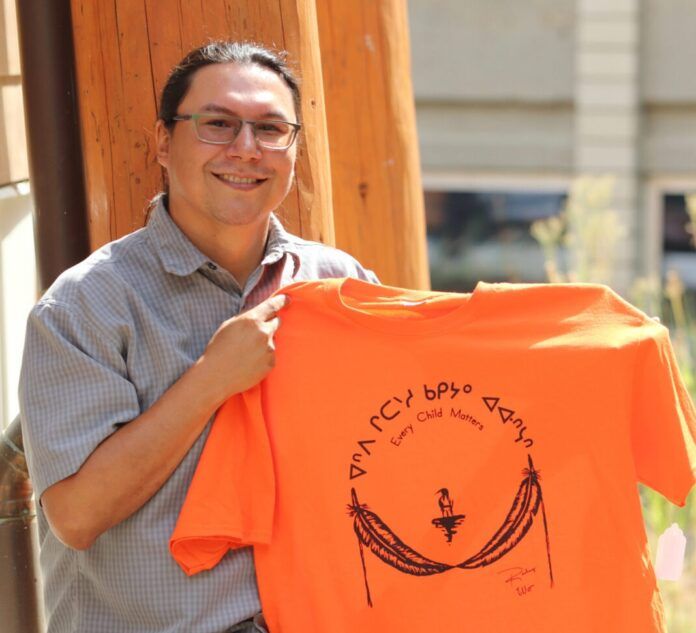The pathway of Indigenous reconciliation is long, but Rodney Noskiye is helping Selkirk College navigate the road to better understanding through building stronger connections.
An alumnus in the school of health and human services, Noskiye returned to the college late last year after working in Northern Alberta as a family support worker. Hired as the college’s first Indigenous student navigator, Noskiye is focused on helping build connections with Nation partners, presenting post-secondary options to Indigenous learners and ensuring a welcoming environment for those who choose to study in the West Kootenay/Boundary.
“It’s about creating a comfort level,” says Noskiye, 39, who grew up in the remote Cree community of Fox Lake, Alta. “Most students who arrive to post-secondary don’t feel they belong in the institution because traditionally there has been hardly any Indigenous presence. Now that I am in this role and personally connected to the culture, I hope they can feel more connected because I can help them navigate through the journey and lead them to be successful in their studies.”
The role of Indigenous student navigator stems from the foundation that has been provided in the college’s indigenization plan. The position supports a decolonial lens for the college and provides ways to bring Indigenous presence, traditions and knowledge forward. From meeting leaders of Nation partners to one-on-one connections with potential students to outreach into the non-Indigenous community, Noskiye has been busy over the last few months.
“The most important part of my role is to make Indigenous students feel at home and a sense of belonging,” he says. “It’s nice to have people come up to me and ask more questions about Selkirk College. We have a lot of programs to offer, so there is a real openness to learning more about this as an option for post-secondary.”
Multi-talented and making an impact
When the Indigenous Services team at the college was looking to generate a unique image for the upcoming Orange Shirt Day on Friday they turned to Noskiye. Counting landscape photography and landscape sketching as a hobby, he accepted the challenge. The result was an image titled “Endless Space” with the words “Every Child Matters” written in both Cree and English.
“It was hard because I wasn’t sure what the image would be until that day I went down to the Columbia River,” Noskiye explains. “It’s a little daunting to create an image that puts everything going on with Orange Shirt Day into one picture. In that moment down by the river, I felt a little lonely. I imagined that is how all the children would have felt when they went to residential school. As I sat down and started drawing, it came to me. It’s a child standing looking into endless space.”
The youngest of nine children, Noskiye’s parents were both torn from their community and forced into residential school. Two of his older siblings were also placed in residential school and an older brother was made to attend day school. Though the generational scars of the system played a continuous role in his early years, the roots of the trauma were never discussed.
“I didn’t even know about the residential schools when I was growing up because nobody talked about it,” Noskiye says. “It was kept a secret and nothing in the curriculum of my own early education spoke about residential schools. Growing up I received very little affection from my parents and siblings, we were taught not to express any emotion and give into the authoritarian teaching they were raised in.”
The older brother who attended day school passed away due to alcoholism and Noskiye says he never had a chance to ask for help. Despite the mistrust his family must have felt towards the Canadian education system and the harm government policy caused, Noskiye’s parents always encouraged him to seek an education. Part of his lifelong learning is understanding the painful history of forced assimilation on his people.
“How can we move forward if we are not informed about what happened to our Elders, siblings and cousins,” he says. “If we don’t know our past, how do we change it so that it never happens again? You can’t avoid it and you shouldn’t avoid it. If you talk about it, hopefully it will inspire people to do better in the future.”
An important day for learning and understanding
Since the Truth and Reconciliation Commission released its final report in 2015 after seven years of gathering the stories and experiences from residential school survivors, the 94 calls to action have been an important part of what is possible in terms of healing and justice. In June 2021, Bill C-5 responded to Action No. 80 and the National Day for Truth and Reconciliation became a permanent part of the Canadian calendar on Sept. 30.
In order to bring about the required outcomes, the National Day for Truth and Reconciliation needs to be embraced by all Canadians. It should not be a considered a day off, but a day to expand knowledge and engage in dialogue.
“You need to build a rapport and make connections,” Noskiye says about the day. “Most Indigenous people are open to speak about their own personal story. It is simple, people just want to be treated with respect. We are actually human, we don’t want to be put on a reserve or in a corner. Just because you didn’t learn about me in school, we are here. I’m here to help you understand how it happened and I am here to listen to you how you feel about it. It is a mutual respect is what we are after.”
Though he is optimistic about what can be accomplished, Noskiye knows the work is just beginning.
“It takes a lot of patience and it is very exhausting,” he says. “When you hear somebody say: ‘Just get over it,’ it is very difficult to sit there and not be able to be heard. Even though the government is with us for truth and reconciliation, we still have a long way to go before there is a true understanding. Non-Indigenous people can’t be nervous to talk about it and they can’t ignore Indigenous people when they tell their story.”
Playing an important part in the ongoing work at the post-secondary level, Noskiye approaches his role as Indigenous student navigator with enthusiasm and optimism.
“With the supportive team at Indigenous Services and the commitment by college leadership, I feel like I can make a few dents while I’m here,” he says.






